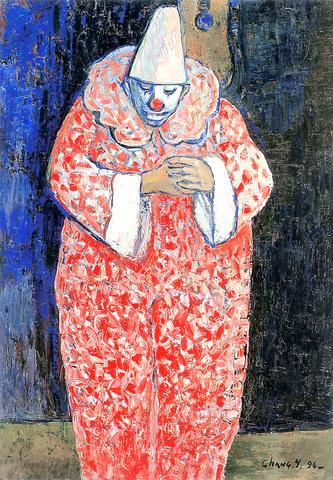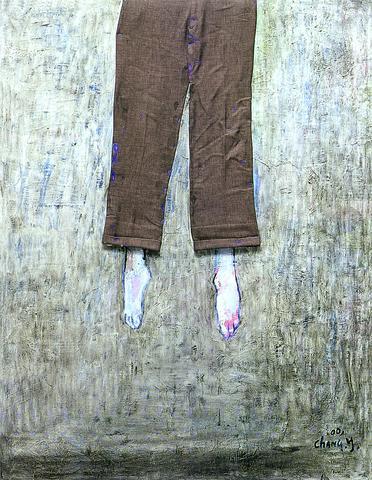Boldness and directness were two of the most distinctive features of Chang Yi-hsiung's (張義雄) work before 1987. Hardened by his poverty-stricken life in Taiwan and Japan, Chang was moved to apply thick and heavy strokes -- often with dark and gloomy colors -- to his oil paintings. This period was categorized as Chang's "period of black strokes" by former director of Taipei Fine Arts Museum Huang Kuang-nan (黃光男).
Before this time, Huang said, Chang painted in the 1960s "with great passion and true feelings, and his vitality was reflected violently in his works."

PHOTO COURTESY OF NATIONAL MUSEUM OF HISTORY
Now, at the age of 90, Chang has outlived most of his local contemporaries and he is still active as an artist. In fact, he takes his art career so seriously that he even thought of hanging himself after believing (for a short while) that he had run out of inspiration as an artist.

PHOTO COURTESY OF NATIONAL MUSEUM OF HISTORY
Interestingly, the idea of committing suicide inspired him to win an award for his multi-media work Zero at the Salon d'Automne in 2001, a place where Chang's works were highly regarded in the past.
When martial law was still a factor in Taiwan in 1987, Chang decided at 73 years of age to settle down permanently with his family in Paris. From this point on, his rocky life took a drastic turn. His European experience enabled him to appreciate the fortune and sweetness of life.
He breathed the air of true creative freedom for the first time and indulged himself artistically, admiring in particular Paul Gauguin, Henri Matisse and Paul Cezanne's masterpieces and their uncompromising spirit toward art.
The following year, Chang became the first Taiwanese artist to receive the French Governmental Annuity for his outstanding achievement in art.
"In sharp contrast to his early works expressing the harsh side of life, or anti-authoritarian sentiments, the color spectrum Chang utilized in paintings -- either in oil or watercolor -- displayed much softer and gentler tones after living in Paris," said Chang's old friend and artist Lee Chin-hsien (
Huang labels Chang's paintings done in Europe "the period of white" for their bright, colorful works which reflect his peaceful state of mind.
The Retrospective Exhibition of Chang Yi-hsiung presents visitors with more than 120 pieces of Chang's art, which cover the period from 1944 to last year.
Chang's works are often categorized into time periods, as already made clear, but they were also divided by subject matter, such as the distinguished "Clown" series.
This is one of Chang's favorite subjects since he sometimes played the clown in real life, either as a way to earn a meager income performing on the street in Japan or to entertain his friends in his early years. The facial expressions of his clowns change from gloomy to smiling, depending on the artist's world view at that time.
Chang's portraits and scenic views can be rather provocative. For example, a large-size tryptich in deep blue colors is called Bottom of the Sea and depicts a scene from an air disaster that occurred many years ago in Taoyuan. It reveals broken bodies scattered all over the place. It is visually shocking, though not
disgusting.
Huang Yun-chuan (黃永川), acting director of the National Museum of History, said that Chang's pursuit of artistic excellence had been long and hard, but it has enhanced his legendary status. Chang's passion for art never faded, he said, and these collected works clearly reflect Chang's every step on the path to great art.

May 26 to June 1 When the Qing Dynasty first took control over many parts of Taiwan in 1684, it roughly continued the Kingdom of Tungning’s administrative borders (see below), setting up one prefecture and three counties. The actual area of control covered today’s Chiayi, Tainan and Kaohsiung. The administrative center was in Taiwan Prefecture, in today’s Tainan. But as Han settlement expanded and due to rebellions and other international incidents, the administrative units became more complex. By the time Taiwan became a province of the Qing in 1887, there were three prefectures, eleven counties, three subprefectures and one directly-administered prefecture, with

President William Lai (賴清德) yesterday delivered an address marking the first anniversary of his presidency. In the speech, Lai affirmed Taiwan’s global role in technology, trade and security. He announced economic and national security initiatives, and emphasized democratic values and cross-party cooperation. The following is the full text of his speech: Yesterday, outside of Beida Elementary School in New Taipei City’s Sanxia District (三峽), there was a major traffic accident that, sadly, claimed several lives and resulted in multiple injuries. The Executive Yuan immediately formed a task force, and last night I personally visited the victims in hospital. Central government agencies and the

Among Thailand’s Chinese Nationalist Party (KMT) villages, a certain rivalry exists between Arunothai, the largest of these villages, and Mae Salong, which is currently the most prosperous. Historically, the rivalry stems from a split in KMT military factions in the early 1960s, which divided command and opium territories after Chiang Kai-shek (蔣介石) cut off open support in 1961 due to international pressure (see part two, “The KMT opium lords of the Golden Triangle,” on May 20). But today this rivalry manifests as a different kind of split, with Arunothai leading a pro-China faction and Mae Salong staunchly aligned to Taiwan.

As with most of northern Thailand’s Chinese Nationalist Party (KMT) settlements, the village of Arunothai was only given a Thai name once the Thai government began in the 1970s to assert control over the border region and initiate a decades-long process of political integration. The village’s original name, bestowed by its Yunnanese founders when they first settled the valley in the late 1960s, was a Chinese name, Dagudi (大谷地), which literally translates as “a place for threshing rice.” At that time, these village founders did not know how permanent their settlement would be. Most of Arunothai’s first generation were soldiers